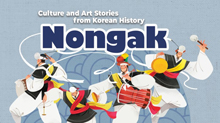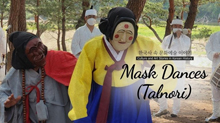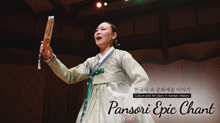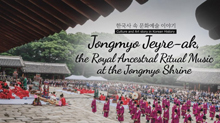The Story of Culture and Arts
- Image resource of Korean history
- Documents from History TextBooks
- Culture & Art Stories from Korean History
- Culture & Art Stories from Korean History - Korean
- National Institute of Korean History
- History net
- About the site
- Introduce
-
Numerous topics related to Korean culture and art are mentioned in middle and high school national history textbooks, but most of them are briefly described by era, making it difficult to understand their concepts, transition processes, and characteristics.
<Culture & Art Stories from Korean History> produces and provides video materials based on expert commentary on the flow, change process, characteristics and characteristics of each major topic in the field of culture and art in Korean history.

Scenario
Pansori, a Korean delight that shook the world.
This centuries-old art form greets the present with new and unique styles.
“Pansori is the songs embracing the histories and lives of Koreans. So we can see it as the essence of traditional Korean culture.” Chae Soo-jung, Professor / School of Traditional Arts, Korea National University of Arts
Let’s learn about the Korean songs that contain joy and sorrow sorrows in their touching melodies, pansori.
Pansori, the Beginning of Pop Culture
The word pansori is made up of two parts, pan meaning “situation or scene” and sori meaning “song”. Together they make the word pansori. When did this art form become a part of Korean culture?
The earliest known mention of pansori is found in a poem from 1754 written by Confucian scholar Yu Jinhan after listening to a song telling the tale of Chunhyang. Based on this poem, pansori is presumed to have begun in the late 17th to early 18th century as a popular performance style that combined stories with music.
What element would be important in making pansori exciting to an audience? The singer of the songs, the sorikkun, would be most important, wouldn’t they?
The sorikkun sings the “chang,” or song portion, as well as speaks a script, called the “aniri.” With theatrical movements called “neoreomsae” and “ballim,” sorikkun leads a performance of fun and excitement.
And opposite the sorikkun is the “gosu.”
The gosu accompanies the song, matching their drumming to the flow and beat. Their occasional exclamations, called “chuimsae,” support the song while also adding excitement to the performance. And the last part of the trio that completes a performance is the cheongjung, or the people who enthusiastically enjoy and react to the show.
In this way, the sorikkun, the gosu, and the cheongjung come together to form this national artform. But you can find its charm and uniqueness not only through the organization of the performance but also its musical elements. What makes pansori so unique is its distinct musical tone and voice, called “seong-eum.”
“To explain the musicality of the “Seong-eum” in Pansori, it can be said that you put clothes on with your voice. Making your voice thin and light, or thick and heavy, powerful or small. With this voice, you can convey emotions and stories to the audience.” Chae Soo-jung, Professor / Korea National University of Arts, School of Traditional Art
A sorikkun who gains full command of their vocal range and proper control of their voice can reach the ultimate stage of Deuk-eum through completing a long period of further training.
Another part of pansori we should point out is the jangdan. The jangdan is the rhythm of the Pansori, and it differs by beat, speed, interval, and dynamic. The gosu will match the musical arrangement by playing quickly or slowly to maximize the impact of the song.
This is why the sorikkun and gosu’s personalities and abilities are so very important. This is most evident during the “deoneum”, the part where the personality and the finely crafted sound of the sorikkun are on display. It is said that all these deoneum parts enrich the stories and music of pansori.
Pansori, how has it changed?
Pansori, a form of culture as well as a historical pastime enjoyed by Koreans for generations. Who enjoyed this art form, and how did it come to change?
From the 17th century to the mid-18th century, pansori was a form of folk entertainment. A short time later began the rise of sorikkun Choi Seondal and Ha Handam, who are considered as the first-generation master singers. As sorikkun gained artistry through training and musical cultivation, pansori gradually became a cultural form enjoyed by all social classes.
The “era of the eight master singers” of the early 19th century in particular brought about rapid changes in pansori. Both the aristocracy and royalty enjoyed watching the performances. Thus began the golden age of pansori.
According to the national custom, for the passers of the national exam, they without fail call upon performers and arrange for extravagant entertainment. - Song Manjae, “Gwanuhui” (On Seeing the Performances of Actors)
The yangban elite of the time invited sorikkun to the “munhuiyeon,” a festival held for those who passed the national civil service exam. At royal banquets, the master singers were awarded official government positions and received much fame. You can imagine just how popular pansori was at the time.
The 12-song repertory established and performed at the beginning of the 19th century was whittled down by the end of the century to a 5-song repertory that included Chunhyang-ga, Heungbo-ga, Jeokbyeok-ga, Sugung-ga, and Simcheong-ga to focus on stories that all social classes could respond to.
Also, between the middle and end of the 19th century, Shin Jaehyo of Gochang worked as a major pansori benefactor, teacher, and musical theorist. He financially backed and debuted the first female master singer, Jin Chaeseon, changing the form of pansori even further.
As pansori continued to develop into a national art form enjoyed by all classes, differences in song characteristics gave way to the creation of yupa, or schools. The main yupa of pansori are Junggoje, Dongpyeonje, and Seopyeonje. The Junggoje style is characterized by its light and firm yet succinct songs. Dongpyeonje-style songs have a spirited voice with a clear finish. Seopyeonje-style songs are filled with flourishes and advanced techniques. Its songs are usually sung slowly.
Yupa are the result of endless experiments and developments in pansori. Influenced by the trends of the time and the needs of the audience, and propelled by the talent of master singers, they became driving forces that enriched the artistry of pansori.
And when pansori reached the 20th century, it began to transform into many more variations. Many female master singers began appearing, the advent of modern theaters, the changgeuk was born. Together with the rise of the five great modern master singers of the time, pansori and changgeuk were extremely popular and performed often.
But later, the number of performances gradually dwindled between the Japanese occupation period and the Korean War in the 1950s. In 1964, pansori was designated Important Intangible Cultural Property No. 5, and the government began paving the way for it to be passed on to future generations and to flourish once more.
In 2003, pansori was selected by UNESCO as a “Masterpiece of the Oral and Intangible Heritage of Humanity,” and in 2008, it was placed on the “Representative List of the Intangible Cultural Heritage of Humanity” and recognized as a World Heritage.
In modern pansori, the art is transforming into something new once more. Through the blending of various genres and compositions, a modern interpretation of the art is emerging, revealing a whole new and original style to Korean pansori.
Transcending language barriers and cultures, it is a precious world heritage that is endlessly passing on its words on new stages.
[Epilogue]
Must-Know Facts on Culture and Art in Korean History
1. Pansori is a national artform that consists of the sorikkun, the gosu, and the cheongjung.
2. When the master singers appeared, pansori began being enjoyed by all classes, and during its heyday, it saw the creation of yupa.
3. The 12-song repertory pansori was revised and passed on as a 5-song repertory. Pansori was then designated National Intangible Cultural Property No. 5 and placed on the UNESCO “Representative List of the Intangible Cultural Heritage of Humanity.”







